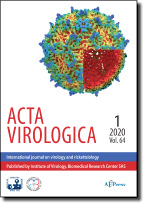Acta Virologica Vol.64, No.3, p.359-374, 2020
|
| Title: Pathological and immunological protection induced by inactivated reverse genetics-based H3N8 equine influenza vaccine candidate in murine model |
| Author: R. Kumar, R. P. Gupta, B. C. Bera, T. Anand, S. Bhatia, N. Kumar, R. Sood, S. Pavulraj, M. K. Mathew, V. Balena, S. Karthik, R. Sansanwal, B. N. Tripathi, N. Virmani |
|
Abstract: Equine influenza (EI) is an important viral respiratory disease of equines caused by influenza A virus (IAV). The antigenic drift in IAVs necessitates regular updating and harmonization of vaccine strain with the circulating virus. The reverse genetics-based recombinant viruses could be easy instrument in generating vaccine against circulating virus in a quick and effective manner. Present study has been envisaged to evaluate the immunogenicity and protective efficacy of inactivated recombinant equine influenza virus (rgEIV) vaccine candidate having six segments from H1N1 virus (A/WSN/33/H1N1) and HA (hemaglutinin) and NA (neuraminidase) segments from H3N8 equine influenza virus [(A/eq/Jammu-Katra/06/08) of clade 2 of Florida sublineage] generated through reverse genetic engineering. BALB/c mice were immunized with inactivated rgEIV adjuvanted with aluminium hydroxide gel and challenged with H3N8 virus (A/eq/Jammu-Katra/06/08). The protective efficacy was evaluated through serology, cytokine profiling, clinical signs, gross and histopathological changes, immunohistochemistry and residual virus quantification. Immunizations induced robust humoral immune response as estimated through hemagglutination inhibition assay (HAI). The antibodies were isotyped and the predominant subclass was IgG1. The vaccine candidate produced mixed Th1 and Th2 responses through stimulation of IFN-γ, IL-2, IL-4 and IL-6 expression. Immunization protected mice against challenge as reflected through reduction in clinical signs and body weight loss, early recovery, mild pathological changes (gross and histopathological lesions) as evident through scoring of lesions, low residual virus in nasopharynx and lungs quantified through egg titration and quantitative reverse transcriptase PCR (qRT-PCR). The study demonstrates that inactivated recombinant EIV generated through reverse genetic approach provides equivalent protection to that observed with inactivated whole H3N8 EIV vaccine.
|
|
| Keywords: equine influenza; reverse genetics; vaccine; pathology; murine model |
|
|
Published online: 21-Sep-2020
|
| Year: 2020, Volume: 64, Issue: 3 |
Page From: 359, Page To: 374 |
doi:10.4149/av_2020_314
|
|
 download file download file |
|
|
|
|
 download file
download file
